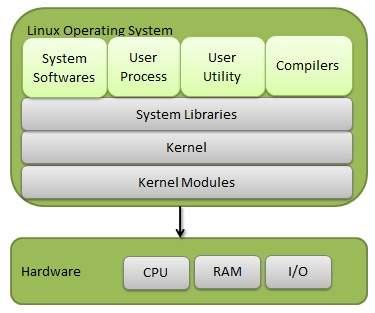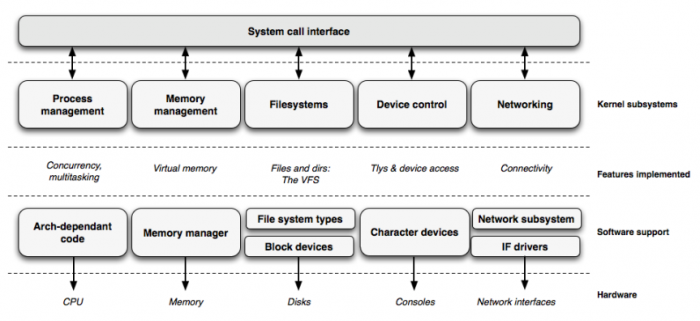Component of Linux OS
Linux Operating System has primarily three components as shown in the following figure -

Credit: Tutorial Point
1- THE KERNEL: "The kernel" is in charge for maintaining all the vital abstractions of the operating system, together with such things as virtual memory and processes. The Linux kernel forms the central part of Linux operating system. It provides all the functionality compulsory to run processes, and it also provides "system services" to give arbitrated and sheltered or protected access to hardware resources. The kernel implements every feature that is required to be eligible as an operating system.
2- THE SYSTEM LIBRARIES: "the system libraries" describe a typical set of functions through which applications can interrelate through the kernel. And which apply much of the operating system functionality that does not require the full rights or privileges of kernel code.
3- THE SYSTEM UTILITIES: "the system utilities" are the programs that execute individual, particular and specialized managing tasks. some of the system utilities may be invoked just once to initialize and configure some features of the system; others (known as daemons in UNIX language ) may run enduringly, conducting such tasks as responding to inward or incoming network connections, accepting logon requests terminals or updating log records and files.
High Level Linux System Architecture

Hardware layer - Hardware consists of all peripheral devices (RAM/ HDD/ CPU etc).
Kernel - Core component of Operating System, interacts directly with hardware, provides low level services to upper layer components.
Shell - An interface to kernel, hiding complexity of kernel's functions from users. Takes commands from user and executes kernel's functions.
Utilities - Utility programs giving user most of the functionalities of an operating systems.
Linux Kernel Architecture

Kernel Components :
File System : It is responsible for storing information on disk and retrieving and updating this information.The File System is accessed through system calls such as open, read, write etc.
Process management : This area is responsible for creating and terminating processes and other activities of the kernel (software interrupts, tasklets, etc.). In addition, this is the area where interprocess communication (signals, pipes, etc.) takes place.
Device drivers : Device drivers abstract from the underlying hardware in every operating system, and they allow you to access the hardware.
Networking : All network operations have to be managed by the operating system, because certain network operations cannot be allocated to a specific process, such as handling an incoming packet.
